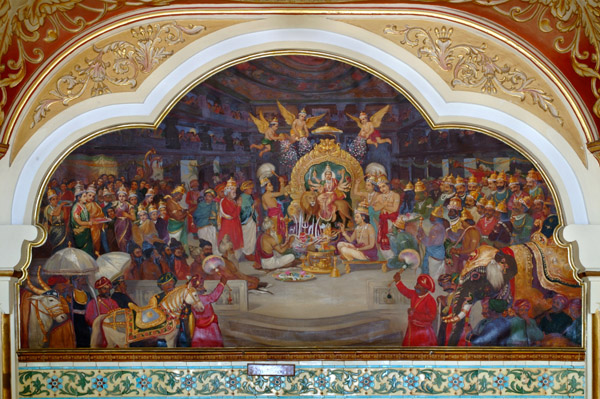Ancient Paintings of India

The tradition of painting has been carried on in the Indian subcontinent since ancient times. Standing as a testimony to this fact are the exquisite murals of Ajanta and Ellora, Buddhist palm manuscripts, Mughal and Kangra schools of miniature Indian paintings, etc. These paintings also provide evidence of the history of Indian music and have helped a lot of historians and research scholars researching Indian music to give an effective conclusion to their respective research subjects. Various important and popular types of paintings are briefly described below.
Cave Paintings
Cave paintings of India date back to prehistoric times. The finest examples of these paintings comprise of the murals of Ajanta, Ellora, Bagh, Sittanavasal, etc, Ancient cave paintings of India serve as a window to our ancestors, who used to inhabit these caves. The cave temples at Ellora were excavated between the sixth and tenth centuries AD, are a fascinating showcase of the evolution of Indian sculpture art, dedicated to three religions – Hinduism, Buddhism, and Jainism. Their paintings made by them are a glimpse of their culture.
Madhubani Paintings
Madhubani’s painting originated in a small village, known as Maithili, of the Bihar state of India. Initially, the womenfolk of the village drew the paintings on the walls of their home, as an illustration of their thoughts, hopes, and dreams. With time, the paintings started becoming a part of festivities and special events, like marriage.
Miniature Painting
Miniatures paintings are beautiful handmade paintings, which are quite colorful but small in size. The highlight of these paintings is the intricate and delicate brushwork, which lends them a unique identity. This painting personifies Ragini Gujari, wife of Raga Deepak mesmerizing a pair of gazelles with the music of her veena.
Mughal Painting
The Mughal painting reflects an exclusive combination of Indian, Persian, and Islamic styles. As the name suggests, these paintings evolved as well as developed during the rule of Mughal Emperors in India, between the 16th century and 19th centuries. The paintings of that period include events, portraits, and scenes of the life of the courts, hunting scenes, and wildlife, and instances of battles.
Mysore Painting
Mysore Painting is a form of classical South Indian painting, which evolved in the Mysore city of Karnataka. During that time, Mysore was under the reign of the Wodeyars and it was under their patronage that this school of painting reached its zenith. These paintings generally depict the images of Hindu gods and goddesses and scenes from the Ramayana and the Mahabharata.
Pahari Painting
Pahari painting is the name given to Rajput paintings, made in the Himachal Pradesh and Jammu & Kashmir states of India. These paintings developed as well as flourished during the period of the 17th to 19th centuries. Indian Pahadi paintings have been done mostly in miniature forms.
Pahari paintings of India can be divided into two distinct categories, on the basis of their geographical range, namely:
• Basohli and Kulu Style (Influenced by Chaurpanchasika style)
• Guler and Kangra Style (Based on cooler colors and refinement)
Rajput Painting
Rajput painting originated in the royal states of Rajasthan, somewhere around the late 16th and early 17th centuries. The Mughals ruled almost all the princely states of Rajasthan at that time and because of this; most of the schools of Rajput painting in India reflect strong Mughal influence.
Tanjore Painting
Tanjore Painting is one of the most popular forms of classical South Indian painting. It is the native art form of Thanjavur (also known as Tanjore) city of Tamil Nadu. The dense composition, surface richness, and vibrant colors of Indian Thanjavur Paintings distinguish them from the other types of paintings.






